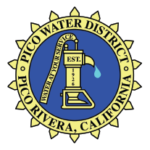YOUR WATER
WATER SUPPLY
WATER SYSTEM FACILITIES
Pico Water District is fortunate to sit on top of the Central Groundwater Basin, a large underground body of sand and gravel that holds billions of gallons of fresh groundwater that is naturally filtered as it slowly moves through these sediments. Because of this, Pico Water District uses wells to pump out this groundwater to meet 100% of our supply needs. Therefore, we do not need to buy more expensive imported water from the Metropolitan Water District of Southern California (MWD), saving our customers money on their monthly water bills.
The basin is replenished naturally by rainfall and river water, which can originate as snowmelt from the San Gabriel Mountains. The Water Replenishment District of Southern California (WRD) adds to this natural recharge through the use of highly treated recycled water from the Los Angeles County Sanitation Districts and the Albert Robles Center. WRD ensures that the basin remains replenished with much more groundwater than Pico Water District needs. Pico Water District’s system is comprised of the following facilities:”
Source of Supply
5 active wells
Reservoirs
1.25-million-gallon
storage tank
Mainlines
52 miles of pipelines
ranging in size from 4 to 14 inches in diameter
Booster Stations
3 booster pumps with a combined pumping output of 2,400 gallons per minute
Meters
5,581 Total meters
WATER QUALITY
Annual Water Quality Report
All water delivered by Pico Water District comes from groundwater wells. The District regularly tests its water and reports the findings in its Water Quality Report, also known as a Consumer Confidence Report, which is published by July 1 each year.
The water provided to the public by the Pico Water District meets all drinking water standards per California Health and Safety Code section 116681 definition (l).
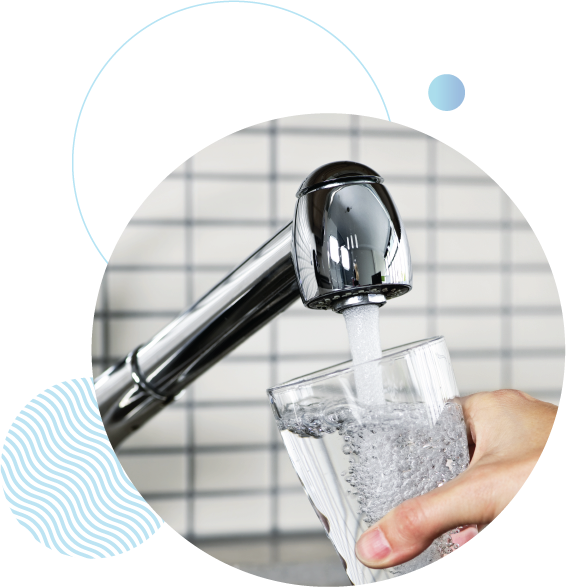
PFOA & PFOS INFORMATION
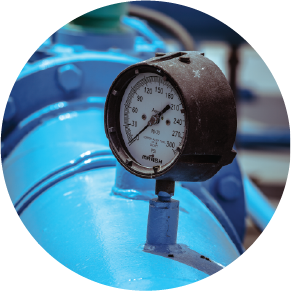
You may have heard news recently about per- and poly-fluoroalkyl substances (PFAS) and their impact on local water supplies. PFAS is the collective term for a large group of synthetic chemicals that includes perfluorooctanoate (PFOA) and perfluorooctanesulfonate (PFOS).
While the water provided to the public by the Pico Water District is safe to drink, our water system recently confirmed a detection of PFOA above the public healthbased Response Level (RL). Although this is not an emergency, as our customers, you have a right to know what occurred, what you should do, and how we are correcting the situation. Click on the links below in English or Spanish to learn more.
To help you better understand these substances and the quality of your drinking water, Pico Water District is providing customers with the resources below. This information includes notices distributed to Pico Water District customers, along with links to government agencies and other experts providing relevant details.
WHY PFOS AND PFOA ARE GAINING ATTENTION
On March 15, 2019, the State Water Resources Control Board (SWRCB) ordered a number of community water systems throughout California to test for a group of chemicals known as PFAS over the course of four quarters (12 months). PFAS is the collective term for a large group of synthetic chemicals that includes perfluorooctanoate (PFOA) and perfluorooctanesulfonate (PFOS). Pico Water District was one of those community water systems that was issued an order to test its groundwater wells. Those tests demonstrated compliance with all state and federal drinking water standards.
These standards include a Notification Level (NL) where customers need to be informed when certain PFAS chemicals are detected and a Response Level (RL) where a water provider is required to take one or more actions to address the detected constituent. The current NL is 5.1 parts per trillion (ppt) for PFOA and 6.5 ppt for PFOS.
On February 6, 2020, the SWRCB announced the lowering of the RL from the U.S. Environmental Protection Agency’s (USEPA) health advisory level of a combined 70 ppt of PFOA and PFOS to 10 ppt for PFOA and 40 ppt for PFOS. Compliance with this new RL will begin with the issuance of new testing orders issued by the SWRCB. Tests conducted before February 6, 2020, are subject to the previous response levels.
Pico Water District regularly tests its drinking water supply at the source and in the distribution system. All water quality tests are conducted by specially trained technicians working in state-certified laboratories. The table below displays the latest testing results.
On March 15, 2019, the State Water Resources Control Board (SWRCB) ordered a number of community water systems throughout California to test for a group of chemicals known as PFAS over the course of four quarters (12 months). PFAS is the collective term for a large group of synthetic chemicals that includes perfluorooctanoate (PFOA) and perfluorooctanesulfonate (PFOS). Pico Water District was one of those community water systems that was issued an order to test its groundwater wells. Those tests demonstrated compliance with all state and federal drinking water standards.
These standards include a Notification Level (NL) where customers need to be informed when certain PFAS chemicals are detected and a Response Level (RL) where a water provider is required to take one or more actions to address the detected constituent. The current NL is 5.1 parts per trillion (ppt) for PFOA and 6.5 ppt for PFOS.
On February 6, 2020, the SWRCB announced the lowering of the RL from the U.S. Environmental Protection Agency’s (USEPA) health advisory level of a combined 70 ppt of PFOA and PFOS to 10 ppt for PFOA and 40 ppt for PFOS. Compliance with this new RL will begin with the issuance of new testing orders issued by the SWRCB. Tests conducted before February 6, 2020, are subject to the previous response levels.
Pico Water District regularly tests its drinking water supply at the source and in the distribution system. All water quality tests are conducted by specially trained technicians working in state-certified laboratories. The table below displays the latest testing results.
| Well Name | Test Date | PFOA Detection Level | PFOS Detection Level | Combined Total |
|---|---|---|---|---|
| #5A | 8/30/23 | 25.75 | 12.5 | 38.25 |
| #8 | 8/30/23 | 20.5 | 13.75 | 34.25 |
| #10 | 8/30/23 | 19.5 | 7.9 | 27.4 |
| #11 | 8/30/23 | 19 | 11.5 | 30.5 |
• Notification Levels on May 9, 2019 – 13 ppt PFOS & 14 ppt PFOA
• Notification Levels were lowered on August 23, 2019, to 6.5 ppt PFOS & 5.1 ppt PFOA
• Response Levels before February 6, 2020, are 70 ppt combined
• Response Levels after February 6, 2020, are 10 ppt for PFOA and 40 ppt for PFOS
As of January 1, 2020, the District will be required to inform all customers of any test results for PFOA & PFOS that exceed the Response Level. Pico Water District has already begun work to construct three new treatment plants to address the treatment (removal) of these chemicals from the District’s wells. The District has purchased the new treatment systems and has approved an agreement with a general contractor. We anticipate having all three treatment plants installed and operational by December 2023.
These types of compounds were widely used in products that resist heat, oils, stains and water such as stain resistant carpets and fabrics, paints, water resistant clothing, fast-food packaging, non-stick cookware, fire-fighting foams and personal care products. As there have been no definitive studies on the quantities of these chemicals that are safe to consume, specific public health goals or maximum contaminant levels have not yet been established. The State is currently researching the impacts of PFAS in our communities. The testing of PFAS continues to be performed as a precautionary health-based measure to inform the public of possible exposures to PFAS chemicals.
Granular activated carbon and reverse osmosis filters can lower the amounts of PFOA and PFOS in water supplies. However, filters are only tested and certified to reduce levels to 70 ppt. They are not currently tested to meet the 5.1 parts per trillion for PFOA and 6.5 ppt for PFOS standards. A database of NSF certified water filters can be found online at http://info.nsf.org/Certified/DWTU/Listings.asp?ProductFunction=P473|PFOA Reduction&ProductFunction=P473|PFOS Reduction&ProductType=&submit2=Search
For additional information about PFAS regulations as it pertains to water supplies, visit the California State Water Resources Control Board Division of Drinking Water website at
https://www.waterboards.ca.gov/drinking_water/certlic/drinkingwater/PFOA_PFOS.html.
The United States Centers for Disease Control provides updated PFAS health information online at https://www.atsdr.cdc.gov/pfas/
The following documents by Pico Water District and other sources offer additional details relating to PFAS, water supplies, testing and regulations:
WATER RESTRICTIONS
During the drought from 2011-2017, a series of executive orders, laws and regulations from the State Water Resources Control Board mandated numerous water conservation measures across California.
On June 3, 2015, Pico Water District adopted Ordinance 62 to permanently implement a series of water conservation policies. This ordinance established water use efficiency requirements and water supply shortage levels in the District’s service area and set forth a penalty system for violators of Ordinance 62. The following prohibitions and water restrictions are now in effect.
Prohibited Actions:
- Watering or irrigating lawns, landscapes or other vegetated areas between the hours of 10 a.m. and 4 p.m. except for very short periods to adjust or repair an irrigation system
- Using potable water for outdoor irrigation for more than 15 minutes each watering day
- Allowing excessive runoff onto an adjoining sidewalk, driveway, street alley, gutter or ditch while irrigating
- Using potable water to wash down hard or paved surfaces such as sidewalks, walkways, driveways, alleys, patios, tennis courts or parking areas
- Using potable water in decorative water features that do not recirculate the water
- Using hoses without a self-closing shutoff nozzle to wash cars
- Using outdoor irrigation during and 48 hours following measurable precipitation
In addition, outdoor irrigation is limited to Mondays, Wednesdays and Fridays. All leaks must be repaired within 72 hours of notification from Pico Water District.
Please see the following documents for additional information regarding water restrictions:
CONSERVATION & REBATES
WATER REBATES
Pico Water District offers rebates for residential and commercial customers who install water-saving devices.
SOCAL WATERSMART
This program offers rebates for turf replacement and water-saving devices inside and outside of homes and businesses. As these programs do change from time to time based on available funding, please visit this site directly for additional information:
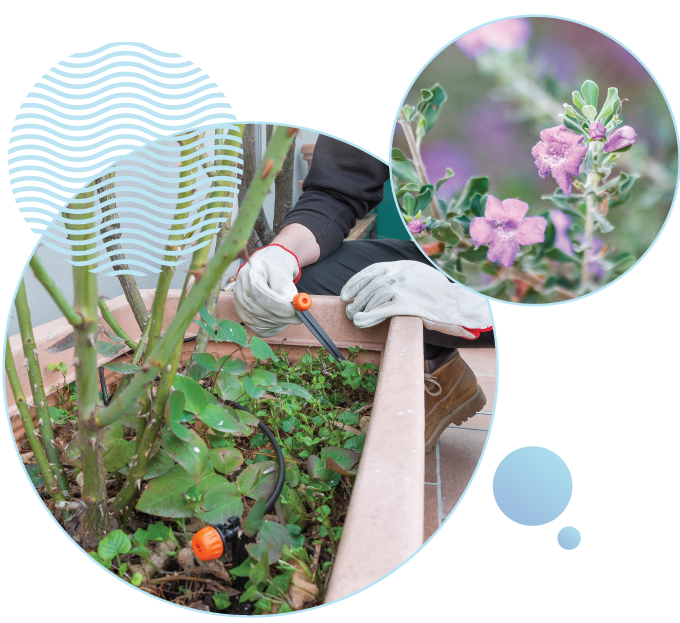
WATER CONSERVATION
There are many ways to reduce water use in your home or business. Improvements in technology mean new appliances use less water than older models. In addition, small changes to water use habits can conserve considerable amounts of water over time.
Visit www.epa.gov/watersense to view information about high efficiency appliances and water-saving tips.
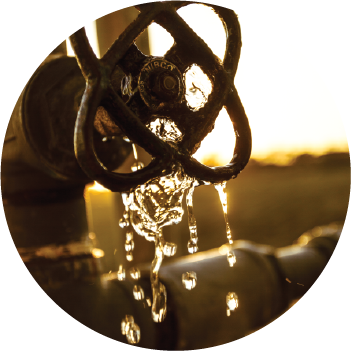
WATER CALCULATOR
Water needs for landscapes change throughout the year. To learn how to properly time your irrigation system, visit www.bewaterwise.com/calculator.html for a custom timing schedule based on your landscape.
FOR KIDS
Looking for a way for kids to have fun while learning about responsible water use? Check out this Activity Sheet filled with games and other activities.
There are many ways to conserve water at home. Kids can check out these water conservation tips around the house to learn about reducing water waste.
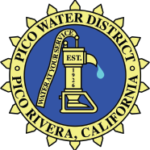
LOCATION:
4843 S. Church Street
Pico Rivera, CA
90660-2102
MAILING ADDRESS:
PO Box 758
Pico Rivera, CA
90660-2102
PHONE: 562.692.3756
FAX: 562.692.5627
